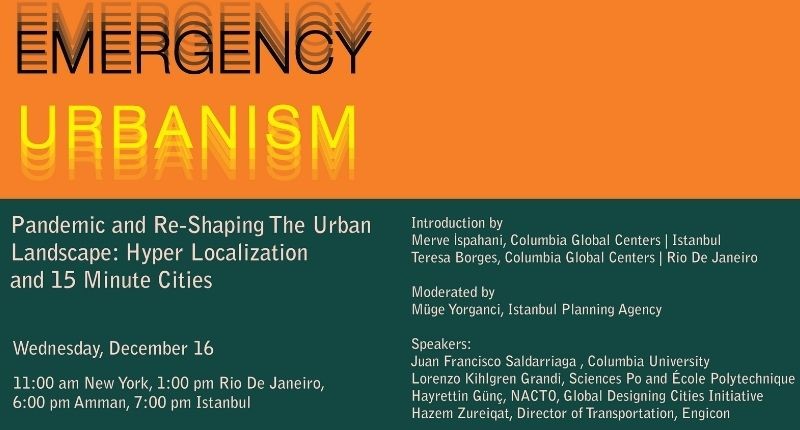Pandemic and Re-Shaping The Urban Landscape: Hyper Localization and 15 Minute Cities

On Wednesday, December 16th, 2020, Columbia Global Centers | Amman, Columbia Global Centers | Istanbul, and Columbia Global Centers | Rio de Janeiro hosted the second webinar in the Emergency Urbanism: Infrastructure and Cities webinar series. This discussion addressed the subject of Pandemic and Re-Shaping the Urban Landscape: Hyper Localization and 15 Minute Cities. The speakers for this webinar included Hayrettin Günç, Juan Francisco Saldarriaga, Hazem Zureiqat, Lorenzo Kihlgren Grandi, and moderator Müge Yorganci.
The event began with opening remarks by Müge Yorganci, where she addressed how the COVID-19 pandemic has altered transportation infrastructure around the world. People are using cycling, private cars, and public transportation more in their day-to-day lives. She also explained the 15 Minute City concept. The concept explains that cities should be designed so that within the distance of 15 minutes that citizens live, they should have access to the full urban experience (i.e., doctors, grocery stores, banks, schools, etc.).
The first presentation that followed was Hayrettin Günç, Program Manager of the Global Designing Cities Initiative at NATCO. His presentation discussed how to ensure that public space in cities represent and serve people who live near them in regards to the role of mobility and how people access space. At the intersection of urban design and mobility, he shared examples of how cities have adapted in the pandemic through practices such as increasing bike lanes and turning streets into vendor stalls, outdoor dining seating, medical testing centers, sites for religious gathering, and protest walks.
Juan Francisco Saldarriaga, Senior Data and Design Researcher at the Brown Institute at Columbia University presented next. His research focused on mapping and visualization and shared his in-progress findings on tracking transportation in NYC during the pandemic. So far, his research has identified a dramatic decrease in subway use across the city, which is partially the result of altered subway schedules and sanitizing practices. He explored the alternative means of transportation that have grown, such as Citi Bikes, motorbikes, and scooters. One primary finding Juan identified was that the drop in subway use occurred before restrictions became mandated by the government, demonstrating that people were making transportation changes before they were forced to do so. His upcoming research will focus on the spatial differences in the use of transportation across NYC neighborhoods.
Next, Hazam Zureigat, Partner at Engicon, Transport Consultant, and Advocate, presented on the specific case of Amman, Jordan. He explained how the movement restrictions in Amman were serious and ranged from curfews to lockdowns to restricted access to public transportation. Some practices that grew during this time included the resurgence of local markets and the use of cycling as a means of transportation. Since the Jordanian government forced restrictions on the public, as opposed to the public electing to make lifestyle changes in response to the pandemic, change has been slow and the public has reverted back to using cars for commuting instead of other means of transportation. Hazam also acknowledged that Amman is a long way from becoming a 15-Minute City, as it lacks infrastructure, topography, and resources to do so.
The final presentation was from Lorenzo Kihlgren Grandi, Lecturer in City Diplomacy at Sciences Po and École Polytechnique in Paris. In his presentation, he discussed connecting the international dimension to the local one through global engagement and hyper localism. He talked about how city diplomacy has been matching global engagement and local strategies through sharing best practices and creating task forces for post-pandemic recovery. One example he provided was in California, where different mayors would connect via Zoom to share strategies. Not all cities, he noted, are engaging in city diplomacy, and several preconditions are necessary for it to be successful. These conditions included decentralization, human and economic resources, leadership and engagement, and strategy. His presentation concluded with a discussion of a consolidation of a methodology for achieving city diplomacy practices and how to apply it to context-specific responses.
To hear the full discussion and Q&A session, click here!